How to Make Vegetable Stock from Frozen Veggie Scraps
Disclosure: This post may contain affiliate links; more info here.
Last year, I volunteered regularly at a lush organic farm just outside Byron Bay, to learn more about farming (and to gain unlimited access to some of the best produce I’ve ever laid eyes on). In between pulling weeds, fending off spiders, and harvesting endless Thai eggplants, I picked up a little trick. I learned how to make vegetable stock from kitchen scraps.
From ends of onions, carrot skins, and celery bases, to the forgotten veggies that have passed their peak, hiding in an obscure corner of the fridge, it can be easy to end up with a heap of veggie scraps destined for the compost bin. And I don’t know about you, but that sight makes me feel a little guilty. A little sad.
So what if I told you that you could give those scraps a new (delicious) life? What if they could be put to good use, and reach their full flavor potential, before returning to the earth? Making homemade vegetable stock from your kitchen scraps is just the way!
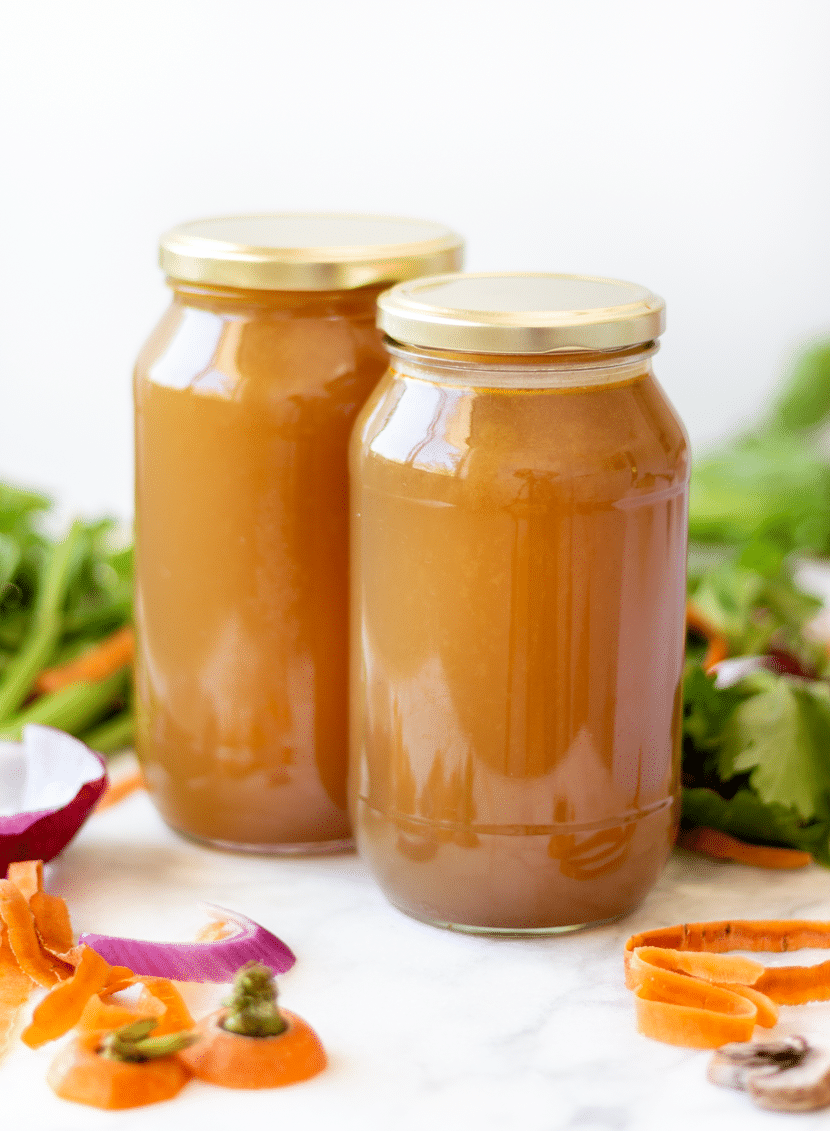
Make Vegetable Broth from Kitchen Scraps
Making your own veggie stock is good for the environment, good for you, super delicious, and almost effortless. If you ask me, there’s no reason not to!
It’s not rocket science, either.
For that reason, I’ll just explain the general how-to instructions behind making your own veggie broth from scraps – not a detailed list of ingredients or exact measurements.
How to Make veggie broth from scraps:
To make your own broth, simply follow these steps:
- As you cook your meals, collect your veggie scraps. See below for which ones are ideal for stock and which ones to compost!
- Throw the veggie scraps into a one-gallon freezer bag, and freeze them. Over the next few days or weeks, continue to add scraps to the bag, until it’s full.
- When you’re ready to make stock, simply throw the scraps into a pot – either a large stockpot or a Dutch oven is best. Fill up the pot with filtered water, until the veggies are submerged and floating. Bring it to a boil, then put the lid on and simmer for at least 30 minutes – the longer the better though! Aim for 2 hours. Don’t have a cast-iron Dutch oven? I recommend this one.
- As the stock simmers, you can add some salt and pepper, to taste. You might also like to throw in some extra ingredients to flavor and tailor your stock for a certain dish or specific cuisine. See below for some ideas!
- Let the stock cool, then strain out the stock from the veggies. If you want to, with clean hands, you can also squeeze out the excess stock from the veggies. You can also use a nut milk bag to make this easier.
- Store the stock in the fridge for up to 4 days, or freeze it for up to 3 months.
If you are looking for some eco-friendly freezer bags, I like to use these ones. They are reusable, BPA-free, leak-proof, and totally awesome! Shop them here!
Freezing Your Vegetable Scraps to Make Homemade Veggie Broth
Veggie scraps can stay in the freezer inside a freezer bag for about six months, no problem.
Every time you cook, add your scraps to the freezer bag and pop it back in the freezer.
When the bag is full to the brim, you’re ready to make your stock.
I recommend these eco-friendly freezer bags. They are reusable, BPA-free, leak-proof, and totally awesome! Shop them here!
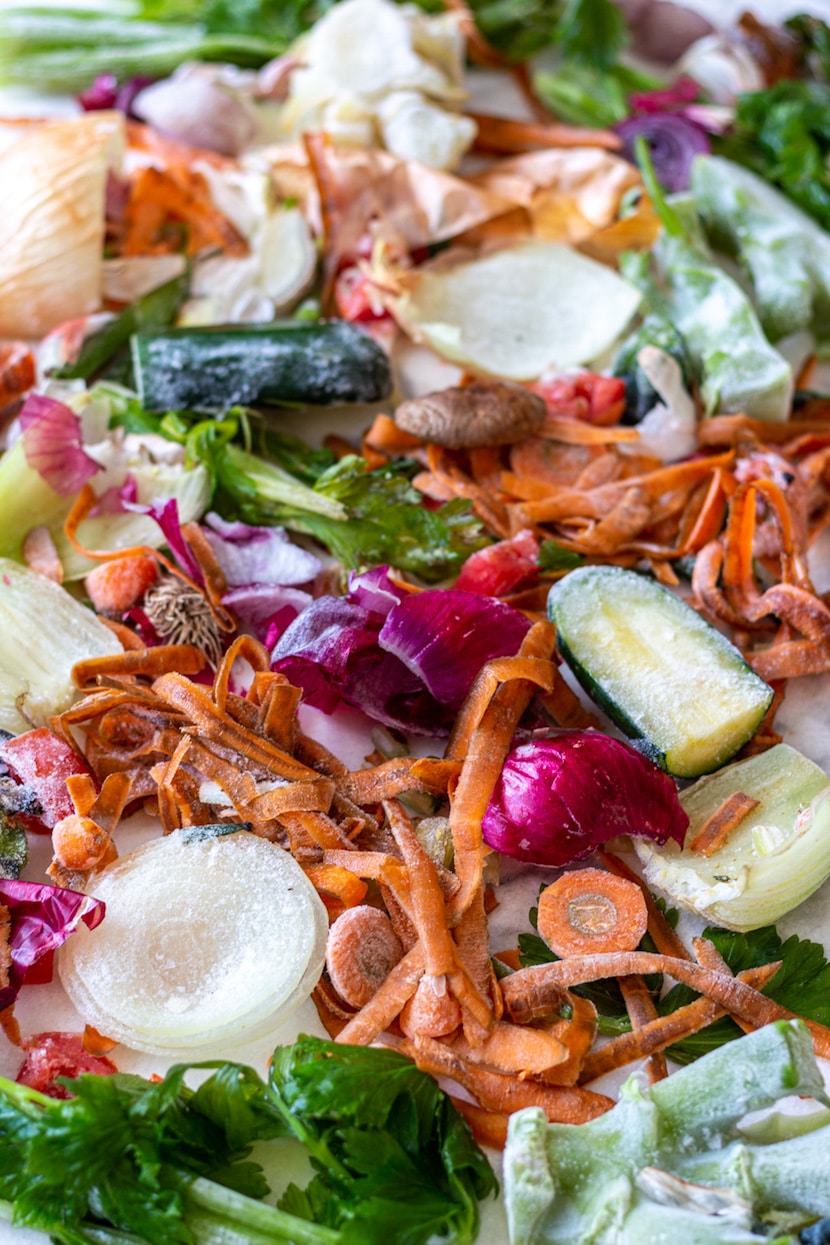
Best Ingredients for Zero-Waste Homemade Veggie Stock
Here are some of the best ingredients to use in your vegetable stock:
- Carrots (tops, bottoms, skins)
- Potatoes (tops, bottoms, skins)
- Onions (tops, bottoms, outer-layers)
- Celery (tops and bottoms)
- Bell peppers (tops, membranes)
- Chilis (tops, membranes)
- Sweet potatoes (tops, bottoms, skins)
- Mushrooms (stems)
- Corn (cobs)
- Asparagus (stalks)
- Pumpkin and squash (tops, skins)
- Garlic (skins)
- Ginger and galangal (peels)
- Any herbs (stems)
- Lemongrass (green parts)
- Tomatoes (tops, bottoms, cores)
- Eggplant (tops, bottoms)
Note, this is not an exhaustive list. Scraps from sweet or fragrant vegetables will work nicely in your stock!
If possible, AVOID using scraps from bitter veggies, such as cabbage, broccoli, Brussels sprouts, kale, arugula, and radishes, as they will make your stock bitter! These can go straight into the compost bin. (A few here and there are fine, though.)
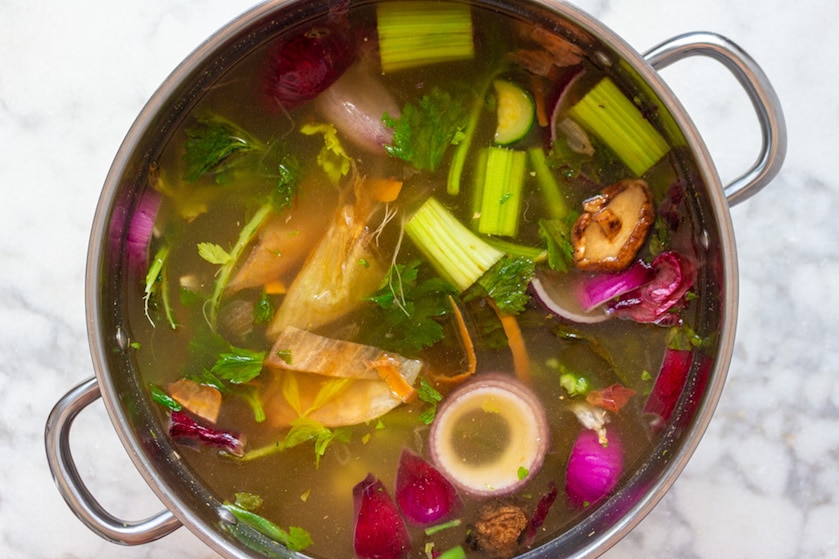
Boost the Flavor with Extra Ingredients
Do you have a specific use in mind for your stock? Are you planning to make an Italian soup like this Classic Vegan Minestrone? Or perhaps you need some stock to make a sauce like my Best Vegan Bolognese Sauce with Lentils, Mushrooms & Walnuts?
Think about how you want to use your stock to inform if you should add in any extras. Maybe you want to throw in more Italian herbs, Mexican spices, or Thai aromats.
For example, you may want to use:
- Dried herbs like parsley, basil, or oregano
- Bay leaves
- Miso paste
- Parmesan rind
- Extra veggies like garlic or onion
- Aromats like bay leaves, ginger, lemongrass, kaffir lime leaves, or chili
Or maybe, you want to keep it neutral – and just well, vegetable-y – by using scraps from basic veggies like onions, carrots, and celery.
The options are endless, so I recommend thinking about the ingredients you usually cook with (or the ones used heavily in your favorite cuisines), and tailoring your stock to achieve more of those flavors!
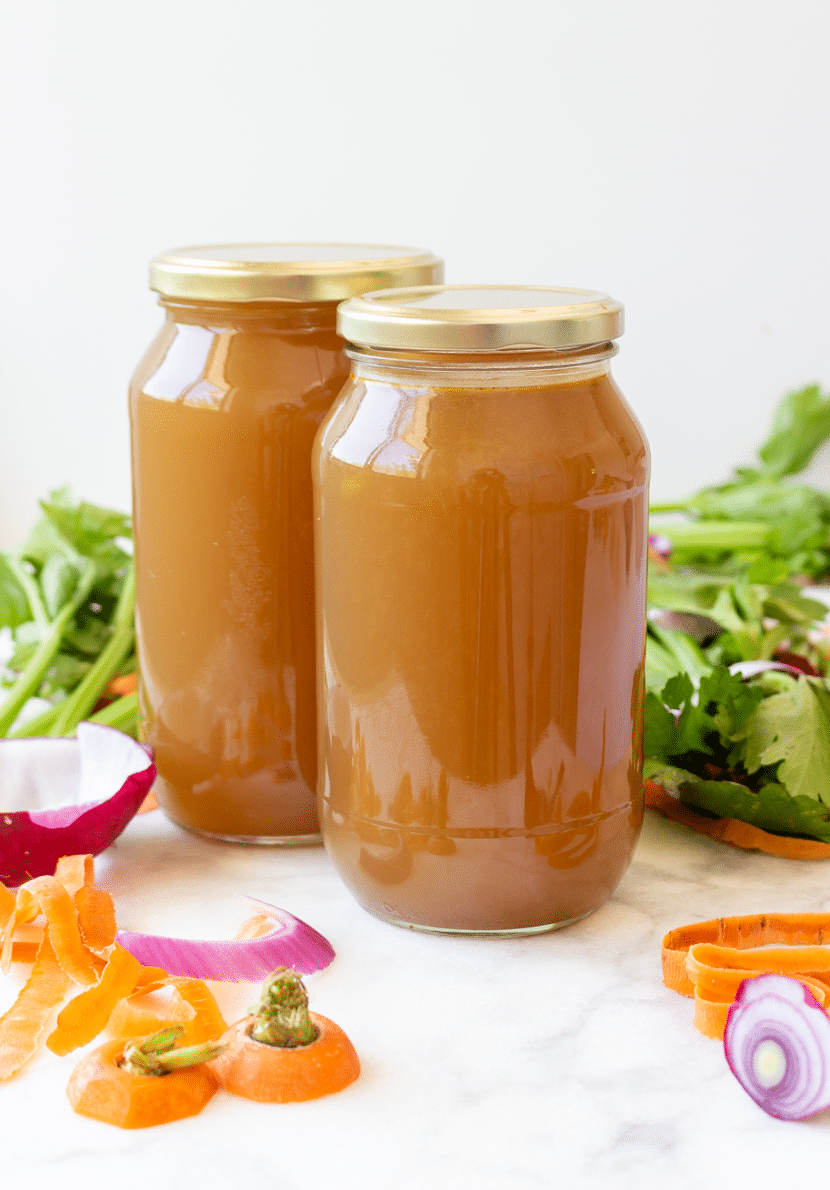
Making Vegetable Stock from Veggie Scraps
Trust me, when you make your own homemade vegetable broth, your meals are so much more delicious. There’s no comparison! That’s a major win, in and of itself.
But also, the process of making your own vegetable stock could not be simpler. Plus, it’s easy on the environment – and your wallet! So it’s actually winning… x4!
So why not start collecting your vegetable scraps in a freezer bag for a cozy, rainy day? That’s the best time to pull out your Dutch oven and make some delicious stock from scratch. :)
If you tried this recipe for Homemade Vegetable Stock from Kitchen Scraps or any other recipe on Maddy’s Avenue, let me know how you liked it! Please leave a comment and rating below. Plus, be sure to follow along on Instagram and Pinterest for more delicious recipes and adventures around the world!
PrintEasy Vegetable Stock from Veggie Scraps
Wondering how to make delicious homemade vegetable stock from your veggie scraps? This easy, 1-pot recipe shows you how – with recommendations on which veggie scraps to collect and how to boost the flavor with extra ingredients.
- Cook Time: 30 mins
- Total Time: 30 mins
- Yield: 1-2 gallons
- Category: Stock
- Method: Stove
- Cuisine: American
- Diet: Vegan
Ingredients
- Olive oil (optional)
- Frozen veggie scraps
- Filtered water
- Extra herbs, spices, aromats (optional)
- Salt and pepper, to taste (optional)
Instructions
- As you cook your meals, collect your veggie scraps. Keep sweet or fragrant vegetables (like onion, carrot, celery, bell pepper, etc.) and avoid bitter ones (like broccoli, cabbage, arugula, etc.) *See recipe notes for a detailed list.
- Throw the veggie scraps into a one-gallon eco-friendly freezer bag, and freeze them. Over the next few days or weeks, continue to add scraps to the bag, until it’s full.
- When you’re ready to make stock, throw the scraps into a pot – either a large stockpot or a Dutch oven is best. Add in some olive oil first, and sauté the veggies first (this will give your stock more flavor and a little bit of “fat”). Or, skip the olive oil and simply fill up the pot with the scraps and filtered water, until the veggies are submerged and/or floating in the water. Bring the stock to a boil, put the lid on and simmer for at least 30 minutes, but up to 3 hours. The longer, the better.
- As the stock simmers, you can add some salt and pepper, to taste. You might also like to throw in some extra ingredients to tailor your stock for a certain dish or specific cuisine (like garlic, chili, lemongrass, bay leaves, dried herbs, or miso paste). *See recipe notes for more ideas.
- Let the stock cool, then strain out the stock from the veggies. If you want to, with clean hands, you can also squeeze out the excess stock from the veggies. You can also use a nut milk bag to make this easier.
- Store the stock in the fridge for up to 4 days, or freeze it for up to 3 months.
Notes
- Veggies to use: carrots, potatoes, onions, celery, herbs, bell peppers, chilis, sweet potatoes, zucchini, lemongrass, mushrooms, corn cobs, garlic, pumpkin, squash, tomatoes, eggplant, asparagus, etc. Any scraps from sweet or fragrant vegetables will work nicely in your stock!
- Veggies to avoid: bitter vegetables such as cabbage, broccoli, Brussels sprouts, kale, arugula, radishes, etc. Bitter veggies will make your stock bitter.
- Ideas for optional add-ons: dried herbs (like parsley, basil, dill, or oregano), bay leaves, miso paste, parmesan rind, extra fresh veggies (like garlic or onion), ginger, galangal, lemongrass, chili, kaffir lime leaves, etc.


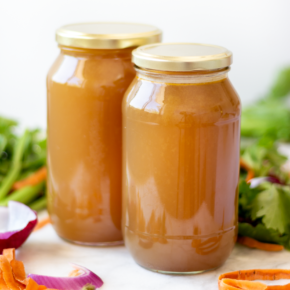

I’m wanting to can it an make it shelf stable, do you know how long I would time it an if I can waterbath or pressure can it? Thanks, I’m looking forward to making this vegetable stock.
Sorry Wanda, I’m really not too sure. I’ve only ever frozen this stock, which is great for a few months.
Why can’t I print this recipe?
Hi Tasha, did you see the “Print Recipe” button? You can also open up this link for the printable version: https://maddysavenue.com/vegetable-stock-from-scraps/print/14913/ (https://maddysavenue.com/vegetable-stock-from-scraps/print/14913/)
Thanks for a great how to with great ideas for flavorings. I am addicted to collecting my scraps now and making my own stock. It tastes so much better than store bought stock.
It took me roughly two weeks to fill up a bag of scraps and now I have jars and jars of veggie stock for making soup! I’m already filling up another bag of scraps. This is such a smart idea, why did I not know about this before!?!
Yay! So glad you have this scrap stock recipe in your repertoire now. Thanks, Jess!